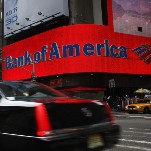Meet the PR Mastermind Who's Managed Woody Allen's Image For Years
LatestOn Wednesday, The Hollywood Reporter published a searing op-ed by Woody Allen’s son Ronan Farrow, in which Farrow discussed but did not name the “powerful publicist” who helps his father continue making movies. On Thursday, “in retaliation for publishing Farrow’s essay,” THR was banned from covering a Cannes lunch for Allen’s new film Cafe Society.
The decision came from Allen’s longtime publicist Leslee Dart, who told THR, “it’s only natural that I would show displeasure when the press goes out of its way to be harmful to my client.” This is not the first time Dart had done something like this; in 2010, she banned Armond White—then at the NY Press, now at the National Review—from a screening of Noah Baumbach and Scott Rudin’s film Greenberg.
This time around, THR missed a lot of action. Allen directly addressed the comment Cannes master of ceremonies Laurent Lafitte had made at the Cafe Society premiere, which appeared to be a reference to both Roman Polanski and Allen (“It’s very nice that you’ve been shooting so many movies in Europe, even if you are not being convicted for rape in the U.S.”), as well as Farrow’s piece. Allen said he had no issues with the joke, and then, in response to a question about Farrow’s piece, he reiterated that he doesn’t read press about himself and had no further comment. More notably, Allen referred to Farrow’s piece as written by a “critic.”
Lafitte’s “joke” did not go over well with some. Blake Lively, one of the stars of Cafe Society, said she didn’t care for it, especially in context of the “beautiful” event they were at. She also said she hadn’t read Farrow’s piece, and therefore didn’t want to talk about it, but that it is “dangerous to factor in things you don’t know anything about” when deciding to work with people.
Lively joins a long tradition of actors who collaborate with Allen and are rarely asked to speak to his controversial personal life, largely due to the tireless work of Leslee Dart, his publicist and Principal Partner of the company 42 West. When Farrow wrote about the “spin machine” that allows Allen to prosper, he was really talking about Dart and her team.
Named one of the most powerful women in New York by Crain’s in 2007, Dart founded 42 West—formerly known as the Dart Group—in 2004, after being dramatically fired from the firm PMK (the same year, PR Week described her as, “not only respected, but genuinely liked”; two years later, Nikki Finke put Dart on her list of influential women in Hollywood). She had been part owner of PMK, and after her ousting over what was deemed a power struggle, many of her clients came with her (Deadline reported she took a third of their roster with her). She now runs 42 West with Amanda Lundberg and Allan Mayer. Dart once said the PR industry should be “less self-centered, and kinder,” but that doesn’t mean her new firm has lived by that mantra, or avoided drama; when a publicist departed 42 West in 2011, another in the industry described Dart as “very imperious, very rigid,” adding that “she doesn’t like dissent.”
On 42 West’s website, Allen’s film Midnight in Paris is listed first in the list of work Dart has helped shepherd. But aside from Allen, Dart works with a all-star list of established filmmakers and actors, including the Coen brothers, Martin Scorcese, and Francis Ford Coppola. She is often thanked in the credits of films she has done PR for, including the documentary short Woody Before Allen.
Also from 42 West’s website, with emphasis added:
Our media relationships—trade and mainstream, business and entertainment, broadcast and online—are second to none… we also recognize that truly strategic communications involves a lot more than just placing stories. It’s about understanding a client’s objectives—whether they are related to growing a business, building a reputation, advancing a cause, creating an image, or promoting an event— and then creating a comprehensive plan to support those goals.
None of this is any different from the work done by PR firms for any other actor or movie out there, but it takes on a different color when you consider Farrow’s claims, and the amount of concealed effort that has likely gone into suppressing Allen’s two biggest transgressions: his affair with and eventual marriage to Soon-Yi Previn, the adopted daughter of his then-partner Mia Farrow, and his alleged molestation of his adopted daughter Dylan Farrow. From Ronan Farrow’s piece:
-

-

-

-

-

-

-

-

-

-

-

-

-

-

-

-

-

-

-

-

-

-

-

-

-

-

-

-

-

-

-

-

-

-

-

-

-

-

-

-








































